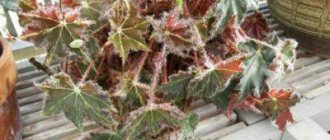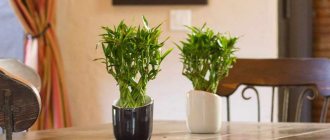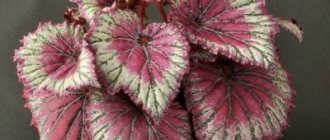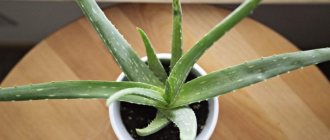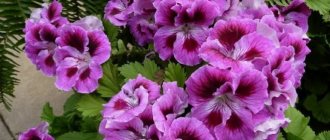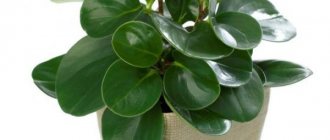Strelitzias are evergreen, herbaceous perennials with unusual flowers and equally exotic leaves, which in their natural environment can reach ten meters in height.
The way the flower is formed and the way Strelitzia is pollinated deserves special attention. The shell from which the “paradise” flower is born is positioned horizontally relative to the surface before flowering and has the shape of a bird’s “beak”. This shell has its own name - “spathe”, which translates as “wrapper”, and can have a length, depending on the type of sterlitium, up to half a meter. The flowers emerge directly from the involucre and have a number of petals, with several joining together in an arrow-shaped shape to form a "nectary". At the moment when a bird, attracted by nectar, lands on a flower, the petals open, throwing pollen onto it, which the bird transfers to other plants.
These green inhabitants of the African continent became known to Europeans at the end of the 18th century thanks to the Scottish naturalist Francis Masson. The name of the genus is given in honor of the English queen. The genus has five species, which are described in detail below. In addition to the main species, there are many hybrids.
Description of the flower and photo
The unusually beautiful shape and bright shades of Strelitzia reginas have made these flowers not only a favorite decoration technique, but also a popular symbol of heavenly beauty. With the help of these flowers they create very attractive and interesting landscapes.
Strelitzia leaves are dark, large, oval-shaped, reminiscent of banana leaves with long petioles. They are arranged strictly in two ranks, forming an evergreen deciduous fan. The thick, waxy and glossy leaves are especially eye-catching.
The width of the leaf blade is 15 - 45 cm long. Usually reaches a height of 4 meters. Strelitzia produces inflorescences horizontally upward, emerging from a thickened stalk.
The inflorescence is located at the top of the peduncle, which can reach 1.5 m or more. The flower is the most unusual part of the plant.
Brightly colored modified leaves form green, red and purple perianths that look like small boats. The perianth size ranges from 10 -20 cm in length, depending on the age and size of the plant.
How it blooms
Each Strelitzia reginas flower consists of three vertically oriented orange sepals and three highly modified bright blue petals. Two petals unite and resemble an arrow, and at the base, where the third petal joins, a nectary is formed.
Each perianth contains two bright yellow or orange and one bright blue elongated petals. The pistil is located quite far from the stamens.
Pollination
The anthers are located in such a way that pollinating insects cannot help but touch them when they fly up to a flower in search of nectar and thus transfer it to another flower.
As a result of pollination, leathery capsules are formed containing many seeds, covered with orange husk. The capsules contain oil, apparently to attract birds and insects.
1.Seven secrets of success:
| 1. Growing temperature: spring and summer - normal room temperature in the range from 18 to 24°C, winter - cool dormant period at a temperature of 10 - 13°C. |
| 2. Lighting: the flower loves bright sunlight - shade Strelitzia only during the hottest hours of the day. Allow the flower to take sunbaths in the morning and evening, every day. |
| 3. Watering and air humidity: abundant but rather rare watering during the period of active growth and almost dry soil in winter, tolerates dry air. |
| 4. Features of cultivation: Strelitzia is unpretentious and forgives many mistakes in care - the flower can be recommended for novice gardeners. |
| 5. Soil: nutritious, with excellent drainage, easily allowing moisture and air to pass to the roots of the plant. |
| 6. Feeding: feed Strelitzia with organic matter or mineral fertilizers during the growing season, 2 times a month. |
| 7. Reproduction: by division during transplantation, less often by seeds. |
Popular articles Gloxinia terry: care and cultivation at home
Botanical name: Strelitzia.
Strelitzia flower - family
Origin. South Africa
What it looks like. Strelitzia are perennial evergreen herbaceous plants that form large tussocks of basal leaves.
The leaves are dark green, paddle-shaped, hard, 30-45 cm long, on long, cylindrical petioles.
During the flowering period, plants form tall, strong peduncles.
The flowers are showy, red or orange and purple, reminiscent of the heads of exotic birds with protruding feathers. Individual flowers remain open for a week, but they replace each other and flowering can last for several months. The flowers have no scent.
After flowering, the bushes form seed pods with rounded peas called seeds. When ripe, the seed pods dry out, turn brown and crack.
Each pea seed is surrounded by a bright orange fluffy base
When the pods crack, this base attracts the attention of birds - they peck the seeds and transport them over considerable distances.
The second name of the plant is “Bird of Paradise” given for the similarity of the flowers to birds.
As plants age, they may develop a low false stem formed by tightly fitting leaf petioles.
Height. In indoor culture it is 100 - 120 cm, grows quickly. In nature, there are individual plants of Strelitzia Nicholas, the height of which can reach 10 m.
Strelitzia planting
Buy a pot for Strelitzia that is large and deep, since the root system develops powerfully, the tap root goes deep into the pot and is located there in a circle, filling the entire space. By the way, when an adult plant of four to five years has completely mastered the space allotted to its roots, then it will bloom more readily. Be sure to place a good layer of drainage material at the bottom of the pot to prevent rotting of the roots from overwatering or stagnation of water in the pan.
Transplanting into a new pot
Young plants are transplanted every spring into new pots 3–5 cm larger than the previous ones. It is more difficult to replant adult plants, since the overgrown root system can be injured during replanting. It is enough to replant them every three to four years.
Replanting should be done by transferring a healthy plant into a wider and deeper pot. At some point you may need a tub - such large specimens are grown by our gardeners in greenhouses and even at home.
The drainage layer and drainage holes at the bottom of the pot should also be larger than those of the old pot. Place a layer of new soil on the drainage, and only then place an earthen ball with your flower there. Fill all the voids around the edges and top of the pot with new soil, shaking it slightly. Water it. Let the flower stand in the shade for some time and get used to the new pot.
How does the Decembrist reproduce?
High-level breeders can create almost any combination of shades of this flower, but only a few know how to propagate Decembrist at home. The task is quite simple; if you fulfill all the requirements of the plant, the flower will successfully take root on the windowsill.
What did the Decembrist transplanted with his own hands turn into?
In order for the Decembrist to be able to settle down after the transplant, it should be carried out according to certain rules. The right time for replanting is at the end of February; for cacti, this period is characterized by the end of flowering and the beginning of the process of increasing leaf mass. Optimal humidity should be maintained; if overwatered, the transplanted cuttings simply rot.
To reduce the likelihood of rotting, you should unscrew the cuttings from the mother flower and dry them for several days in newspaper. Such a simple operation will allow microcracks to heal.
Important! It is correct to unscrew the cuttings clockwise, and not to cut them. When cutting, the plant is more injured, which reduces the likelihood of successful transplantation
It is imperative to maintain the optimal room temperature at 17-20°C; Decembrist reproduction in such a climate will occur without drying out or rotting.
An important role is played by the choice of plant propagation method from the following options:
- using seeds;
- cutting method;
- sheets;
- The grafting method is also suitable for flowers.
Decembrist transplantation by cuttings
Growing a plant in an apartment is not difficult if you choose the optimal zone for this. In the apartment, temperature and humidity indicators practically do not change throughout the entire time, which is a favorable condition for the flower.
The most recognized and highly effective method of transplantation is the cutting method. Taken cactus shoots quickly take on new roots, do not require constant care and have a low threshold for fungal diseases.
Strelitzia care at home
Growing Strelitzia at home is not difficult, but in order for it to bloom, it needs a lot of light and space to grow.
Lighting and location
Bright lighting is necessary; you can keep Strelitzia on a south-facing window, but it is not advisable to immediately place it in the sun. It is better to make sure that the plant gradually gets used to the sun. Shading will be needed if the “bird of paradise” stands in the sun in the summer heat. An eastern window is preferable, where the sun is in the morning, when the air temperature is not yet high.
In summer, it is useful to place Strelitzia in the garden, on the balcony, this promotes abundant flowering in the future.
Temperature, watering, fertilizer
Strelitzia prefers moderate or cool conditions in winter at a temperature of about 14-15 °C, minimum 12 °C. In summer, the normal room temperature, it is desirable to ensure a fluctuation in night and day temperatures, which is easy to implement outdoors.
- Air humidity. Not significant. It is useful to periodically spray and wash off dust.
- Watering. Abundant from spring to autumn, in winter, in a cool room, Strelitzia begins a period of relative dormancy, so water only occasionally, but in any case the soil should not dry out completely.
- Fertilizer. From March to August, fertilizing is carried out every 2 weeks with liquid fertilizers for flowering indoor plants. When maintaining a garden, it is useful to water it with organic fertilizers.
Transfer
Strelitzia is replanted as needed; adult plants are usually replanted after 2 years. Unlike most indoor plants, Strelitzia feels good and blooms only when it has a spacious pot, so it is advisable to grow it in large flowerpots and tubs. The root system develops mainly in length, so choose a high pot.
When replanting, be careful, as the fragile roots of Strelitzia are easily broken. It is better to transfer it to a larger pot.
The soil
The soil required is the most nutritious. More often, a substrate is used from a mixture of turf, humus, leaf soil and sand in a proportion (2:2:2:1) with the addition of peat, as well as from leaf humus, turf soil and sand (2:1:1). Good drainage in a pot is a must.
The eternal question: should I trim the leaves or not? Let's look at both.
No trim:
In August, stop watering and put the bush in a dark place until autumn. If the flower is found in the garden, where hippeastrums are sometimes planted for the summer, you need to dig it up. Naturally the leaves will turn yellow and die. They need to be removed. The pot is placed on the window in winter. Only after this does watering begin. Result: it will bloom in a month.
With trim:
In July, leaves are cut from the bush. Watering stops for exactly four weeks. In the fifth week, the first watering with fertilizing is appropriate. As a result, wild color is promised in September.
Blooming hippeastrum is constantly turned. So that the peduncle does not bend. The turn is done smoothly.
This exotic beauty feels better on southern, south-eastern and south-western windows. Loves light, but is afraid of direct sunlight. Which can lead to leaf scorch. For this reason, they should not touch the window glass. Temperature is standard room temperature. Caring for the leaves is simple - gently wipe with a damp cotton pad.
Reproduction
At home, Strelitzia is propagated by division, but you can also try it with seeds. The divided parts of the rhizome must have at least 2-3 growth points. Divide carefully, the roots are fragile. The “bird of paradise” propagates by seeds, dividing the bush and planting rooted side shoots.
Seeds
When propagating by seed, only very fresh seeds are used, since they quickly lose their germination capacity - already six months after ripening. Seeds need to be prepared for sowing:
- remove orange hair tufts.
- Before sowing in the ground, they are soaked in water for 1-2 days, but it is better to soak them in a solution of phytohormones to speed up germination.
- then plant in well-drained soil from a mixture of peat and leaf soil to a depth of 1.5 times the size of the seed.
When soaking and germination, it is necessary to maintain a constant temperature of at least 25 degrees. Lower temperatures delay the germination process. But even under such conditions, they germinate unevenly and for a long time: from 1 month to 1 year or even more.
The first transplant into well-drained soil is carried out in the phase of 2-3 leaves. Further transshipment of growing specimens is done depending on the filling of the pots with roots, without waiting for the very dense entanglement of the earthen coma, which can negatively affect the growth rate. It is necessary to replant carefully, without damaging the very vulnerable fragile fleshy roots; this also affects the growth rate.
Only in the second year are the seedlings planted in a permanent place. They are kept in warmer conditions compared to adult plants. Young plants must be protected from direct sunlight, as they can burn sensitive leaves.
You can expect the first flowering of plants grown by seed method no earlier than in 3-4 years, or even in 5-6 years.
Dividing the bush
You can propagate the African beauty by dividing the rhizome, which in Strelitzia is very fleshy, like in all plants of the ginger order. When dividing, you need to make sure that each part has at least one shoot, preferably two. Division begins after flowering, which under indoor conditions can begin in late winter - early spring and lasts until May-June.
Side shoots
When propagated by lateral rooted shoots, they are carefully separated, preserving the roots, and planted in separate pots. The soil mixture is made up of 2 parts turf soil, 1 part leaf soil, 1 part humus and 0.5 parts sand. A crock or drainage is placed at the bottom of the pot, and then the soil mixture. Rooting takes place at a temperature of 22 degrees.
Strelitzia is a rather slow-growing plant , and after part of the rhizome is separated, the young plant needs at least two years for it to grow into a powerful, profusely flowering bush.
How to grow vegetatively?
There are two options for propagating Strelitzia vegetatively:
- by dividing the root;
- using side shoots.
Using division
Experienced gardeners note that the best time to divide the plant's root is after flowering. The plant must be planted carefully so as not to damage the roots during the replanting process.
Wide, suitable-sized pots are prepared for the resulting seedlings.
Side shoots
The separation of side shoots occurs as follows:
remove the plant from the pot, clean the roots from the ground; if there are damaged areas, they must be trimmed with scissors; determine the most suitable side shoots for propagation and carefully separate them from the main plant; treat the cut with charcoal powder or, if necessary, with a fungicide.
When dividing the root, you need to ensure that the root has from one to three shoots. You need to be very careful when doing this - the Strelitzia root is quite fragile. Transplanted plants must be kept at a temperature of 22°C.
Choosing a pot
When choosing a pot, you should remember that Strelitzia prefers space; in a cramped pot, its roots will grow outward. The diameter of the pot is selected according to the age of the plant - the older it is, the wider and more spacious the pot should be.
The pot should have several drainage holes at the bottom.
Composition of the earth mixture
For a flower to grow strong and beautiful, loose and nutritious soil is needed.
It is important that the soil has good air and water permeability
The soil composition should include:
- sand;
- peat;
- humus;
- leaf soil.
All this should be in equal proportions. Charcoal is added to the drainage.
You can prepare the substrate yourself by first disinfecting all components in an oven or microwave oven. Also suitable for Strelitzia is soil for indoor flowers and plants, which can be purchased at the store.
Landing
Planting a Strelitzia root is not much different from sowing its seeds. To do this you need:
- If the container in which the flower will be planted does not have drainage holes at the bottom, then you need to make them yourself. The holes should be approximately 5mm in diameter.
- Fill the pot 2/3 full with soil.
- Pour boiling water over the prepared soil, crush it and let the soil cool.
- Add sand to the soil so that its layer is two centimeters. Plant a root.
- Add the remaining soil and water again.
- Place the seedling in a bright room, maintain the temperature at 22-24°C. Remember that direct sunlight is unacceptable for Strelitzia.
- Create a greenhouse condition for the flower. To do this, you need to cover the pot with a plastic bottle, after cutting it off. After a week and a half, the bottle can be removed.
There are many varieties of Strelitzia, but the most amazing and unusual of them is the Royal one.
Growing Strelitzia at home is quite easy if you follow the basic rules. Taking care of the flower, maintaining the right climate and timely watering will allow you to admire the luxurious flowering of an unusual plant for a long time.
Strelitzia flowering
Only a large plant in a sufficiently spacious pot can bloom. The flowering time of Strelitzia directly depends on the cold period: if in winter it was kept at a temperature of 12-15 degrees, it will bloom profusely in the summer, and if it is provided with about 15 degrees in the summer, it can bloom in October.
With proper care, Strelitzia is resistant to pests.
Why doesn't Strelitzia bloom?
There may be several reasons why Strelitzia does not bloom at home:
- Perhaps you don’t feed her enough, but she likes to be fed every 10 days with either organic matter or mineral fertilizers during the active growing season and preparation for flowering. You can use complex fertilizers for blooming indoor flowers.
- Also check whether the flower has a suitable pot. If it is too large, then flowering will not occur until the root system of the flower has completely mastered the soil space. And if the pot is too tight, the roots rest against the walls and crawl out of the drainage holes, you will have to transplant the plant into a suitable container and wait another year for flowering.
- Remember if Strelitzia had a dormant period last winter or fall, during which it would rest and gain strength for flowering. The conditions must be appropriate: cool room, moderate watering, no fertilizing. If this was not the case, then you will have to provide it with these conditions this winter, then Strelitzia will definitely bloom next year.
How to make Strelitzia bloom
Strelitzia begins to bloom in early spring. Its flowers appear alternately from brightly colored bracts. White, yellow, lilac, blue and light blue (depending on the type) – you can’t take your eyes off them. The owner of a blooming specimen of an indoor flower always wants to see this very bloom as soon as possible. But in the case of Strelitzia, you will have to wait 4 - 5, or even 6 years for flowering. Even after reaching the adult period of its life, the plant may not bloom.
To make it bloom regularly and luxuriantly, in the winter months it is placed in a cool room, up to 12 - 14 degrees Celsius, with moderate watering, without fertilizing and bright light.
One to two months of such spartan conditions is enough, and return the plant to its warm place with diffused sunlight. Start feeding and watering the unfortunate plant regularly. Use special preparations that accelerate flower set (pollen, ovary). Strelitzia is a very grateful creature. Now it will definitely bloom.
What to do to see the blooming flowers?
To understand why your pet does not bloom, you need to analyze every factor in caring for the plant and find errors in them that should be eliminated immediately.
Flowerpot size
The reason may be due to excess space. There shouldn't be a lot of it. The pot should be as small as possible. Ideally, the root system should be even a little cramped in its “home”. You can avoid replanting Hoya for at least five years.
Lighting
There should be a lot of light all the time. But if you place the flower on the south side of the room in the summer, make sure that you have the opportunity to shade the ivy during the hottest rays. Use reflective foil or just a sheet of paper for this. Experienced people recommend avoiding open air for this vine.
Proper watering
Rare watering is considered correct. After each moistening of the soil, wait until it dries completely. This applies to the hot summer period.
But if we talk about the cold season, then in this case you should not rush to water even after the soil has completely dried out.
Good drying of the soil and root system in winter is the key to abundant flowering of zoya in summer.
Wintering
At this time of year, you need to give the plant the opportunity to rest and gain strength for the new season. In winter you need to provide the following conditions:
- minimal soil moisture;
- reducing fertilizing to nothing;
- reducing the room temperature to 10-14 degrees above zero.
Substrate
The soil must be loosened, soft, and breathable. To properly prepare the soil for wax ivy, take ready-made store-bought substrate, peat and sand in equal proportions.
Top dressing
It should not be frequent in any season. In addition to ready-made complex fertilizers, gardeners recommend feeding the vine with mullein. Such nutrition will have a positive effect on subsequent flowering.
Age
This factor must be taken into account while waiting for the first flowers from hoya. After all, young plants will not be able to bloom. This process should take a couple of years. Flowering in the first year of “life” is extremely rare.
"Bathhouse"
This method of making a vine bloom is considered extreme.
It is used in cases where all of the above methods do not help to achieve flowers. What do I need to do?
- In autumn or winter, place the ground part of the ivy in water heated to 35-40 degrees for about half an hour.
- Soil with the root system in the same water - for an hour and a half.
This process activates all life processes of the plant, including flowering.
If the result is not noticeable the first time, you can repeat the procedure, but not earlier than six months later.
Diseases and problems during cultivation
Indoor Strelitzia, subject to normal growing conditions, rarely gets sick. However, any disturbances in water or temperature conditions can provoke diseases of the roots or leaves of the plant. Let's consider the possible problems of growing the Bird of Paradise.
- If dark spots appear on the leaves of Strelitzia, the reason lies in an excess of moisture in the root system. Check whether there is a sufficient layer of drainage in the pot, whether excess moisture is stagnating in the tray, think about whether you water your pet often. Correct the situation. Cut off the affected leaves.
- If the roots begin to rot, the flower should be removed from the pot, the affected parts of the roots should be removed, and the sections should be treated with crushed charcoal or activated carbon. Strelitzia will have to be transplanted into another soil and avoid the same mistakes.
- If the edges of the leaves and their tips turn brown, the air in the room is too dry. It is necessary to spray the plant regularly; in addition, place the flower pot in a tray with wet expanded clay, turn on the humidifiers if you have them.
- If during flowering Strelitzia suddenly begins to drop buds, the reason may lie in moving the plant from place to place or turning the pot on different sides to the sun. Royal Strelitzia doesn't like to be disturbed while it's blooming!
- If the leaves of Strelitzia begin to wither and turn yellow, the plant may be cold. If this happened during the winter months and the pot is intentionally kept in a cool room, we still recommend moving it to a room with a higher temperature. The lower temperature threshold for Strelitzia is 12 degrees.
- If the leaves of a flower begin to spontaneously crack at the tips and tear, it means that the plant is under stress from temperature changes or irregular watering. Draw conclusions. Correct the situation.
Step-by-step instructions for the procedure
Seed selection
The main thing you need to pay attention to when choosing seeds is their shelf life. You need to know that the older the flower seeds are, the worse it will germinate. Therefore, you need to choose seeds that were packaged no later than six months ago.
In addition to the expiration date, it is important to pay attention to the following:
Soak
Proper preparation of seeds for planting increases their chance of successful germination:
To increase the chances of grain germination, experienced gardeners advise replacing the water when aging seeds with special phytohormones. This type of medication must be used strictly according to the instructions.
Preparing the soil and container
Soil for strelitzia can be purchased at the store or made yourself. For the last option you need:
All components are thoroughly mixed. It is allowed to add humus to the finished soil.
Sowing
Before you start planting seeds, you need to fill the glass 2/3 with soil and pour boiling water over it. After the water stops flowing and the earth has cooled, you can begin planting:
Temperature
The temperature in the room where the containers with Strelitzia seeds are located should be 24-25°C.
Deadlines
Taking into account that fresh flower seeds were taken for planting and the conditions were correct and favorable, we can expect that the first sprouts may appear in a month and a half. But it is worth considering that seeds can germinate up to six months.
Moisturizing the soil after germination
It is necessary to start moistening the soil only after the seed has sprouted. The sprout is watered with boiled water at room temperature.
Watering
The soil for Strelitzia must be kept moist at all times. But at the same time, overflow and stagnation of water should not be allowed. In this case, the root system begins to rot, which will lead to the death of the flower.
To maintain the water balance of the plant and not flood it, Strelitzia is regularly sprayed and wiped with a damp cloth.
Lighting
For rapid growth and long flowering, you need to find a suitable place for the flower, where there is enough free space and good lighting. Often a window facing west or east will provide the right light.
If this is not possible, Strelitzia can be placed on the south side of the apartment. In this case, it is necessary to create conditions under which the plant will not be exposed to direct sunlight, otherwise it may die.
Some popular types of Strelitzia
Strelitzia white/blue "White Bird of Paradise"
Strelitzia White or Strelitzia Augusta is a perennial plant native to South Africa. This species got its name because of the white petals of the flower. The plant is powerful, up to 6 meters in height. It has several straight single trunks with a woody lower part and huge elliptical shiny light green leaves up to one meter in length. Moreover, at the base some leaves are heart-shaped. Strelitzia's peduncles are axillary, with two lanceolate bracts, with a single purple spathe. White flowers reach a length of 20–30 cm, a height of 7.5 cm and a thickness of 5 cm. The petals of the flowers are snow-white. The upper one is in the shape of a lancet, and the lower one is similar to a boat. The filaments of stamens are 3 cm long, with anthers – up to 5.5 cm.
Strelitzia Nicholas - “Giant Birds of Paradise”; "Wild Banana"
Strelitzia montana is the rarest tree-like species found in the very south of Africa. Locals call this tree the Desert Banana. It grows up to 10 meters in height and has huge leaves that grow in two rows and clasp the bottom of the tree trunk. The flowers are also large, white, with pointed, red, boat-shaped bracts. The flowers reach 45 cm in length.
Strelitzia reginas / S. parvifolia
Strelitzia reed is very similar to reed. This species grows in the East of South Africa. It tolerates sudden changes in temperature, even sub-zero, and can withstand prolonged drought - such a cold-resistant and drought-resistant plant. Its orange-blue flowers are similar to the Royal flowers, but the leaves are different - large, narrow, needle-shaped. They grow in a dense bluish-green rosette and reach a diameter of two meters. Flowering lasts from May to October.
Strelitzia caudata / Strelitzia "Desert Banana"
Trimming
Strelitzia flowers last about three weeks before the petals drop and die. Remove old or damaged plants. This is the best way to thin out the leaves. Remove leaves by tearing them off or use sharp cutting tools. Sterilize instruments between different plants. If the leaf looks mostly healthy, leave it untouched. If your plant has gotten very large and you need to trim it back significantly, use a lopper, hand pruner or saw to prune in early spring. Do not use hedge trimmers that leave jagged cuts. You can trim all the leaves and stems just above the ground. If the plant remains too bushy, use long-handled pruners and remove selected stems and leaves.
Seed preparation
After purchasing seeds, they need to be properly prepared for planting. For 36-48 hours, Strelitzia seeds are soaked in warm water (+35...+40°C), having previously cleared them of dark yellow hair tufts. After swelling, the remaining fruit pulp is removed from the seeds (if there are any, of course). However, keeping seeds in ordinary warm water will not guarantee good plant germination. Some experienced gardeners recommend purchasing special phytohormones for aging seeds before planting. You need to use such additives according to the instructions for use or simply by asking the seller about the specifics of using a particular drug specifically for Strelitzia.
Requirements for planting material
When purchasing seeds, you should pay attention to the expiration date indicated on the package. The main requirement for planting material is its age. It should be noted that the older the flower seeds, the lower the germination rate of the seed will be, which means it is better to buy only those that were packaged no more than 6 months ago.
Did you know? Today there are 5 types of Strelitzia, one of which is named after Nicholas I.
In addition, you should pay attention to the dryness, cleanliness, and uniformity of the seeds. The seed must be pure grade and without signs of various diseases, so it is better to buy seeds from trusted sellers.


